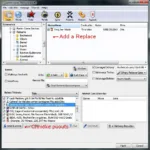Uncovering hidden damage in a car can be tricky. Whether you’re buying a used car or assessing damage after an accident, knowing the right tools to find hidden damage in cars can save you time, money, and potential headaches down the road. From simple visual inspections to advanced diagnostic equipment, this guide will equip you with the knowledge to confidently assess a vehicle’s true condition.
Choosing the right tools and techniques can significantly impact your ability to find hidden problems. From frame damage to flood history, uncovering these issues is crucial for making informed decisions. Let’s explore the various methods and tools that can help you become a savvy car inspector. You can also learn more about specific diagnostic procedures with our guide on computer diagnostic test on cars.
Visual Inspection: Your First Line of Defense
A thorough visual inspection is the first and most accessible step in finding hidden damage. While it might seem basic, a keen eye can catch many telltale signs.
- Check for inconsistencies in paint: Look for overspray, mismatched colors, or areas where the paint appears thicker than usual. These could indicate prior bodywork.
- Examine panel gaps: Uneven gaps between body panels can be a sign of misalignment due to previous damage.
- Inspect the undercarriage: Look for rust, dents, or welding marks, which could suggest frame damage.
- Check for signs of flood damage: Look for water stains, mildew, or a musty odor inside the car, especially in the carpet and trunk.
After completing a visual inspection, consider utilizing professional diagnostic services for a more in-depth assessment. For locations near you, check out our guide on places that do diagnostics on cars near me.
Advanced Tools for Deeper Insights: Unmasking Hidden Issues
Beyond visual cues, several advanced tools can provide deeper insights into a car’s condition, helping to uncover hidden damage that might not be visible to the naked eye.
Paint Thickness Gauge: Unveiling Repainted Areas
A paint thickness gauge measures the thickness of the paint on a car’s body panels. Variations in thickness can indicate areas that have been repainted, potentially masking previous damage.
- How it works: The gauge uses magnetic or ultrasonic technology to measure paint thickness.
- What to look for: Significant variations in readings across different panels or within the same panel can suggest repainting.
OBD-II Scanner: Decoding Electronic Clues
An OBD-II scanner plugs into your car’s diagnostic port and retrieves information from the vehicle’s computer. This data can reveal potential problems with the engine, transmission, and other systems. You can learn more about electrical diagnostics by checking out our guide on electrical diagnostic testing for cars.
- How it works: The scanner communicates with the car’s onboard computer and retrieves diagnostic trouble codes (DTCs).
- What to look for: Specific DTCs can point to underlying issues that may not be readily apparent.
Endoscope: Exploring Hard-to-Reach Areas
An endoscope is a small camera attached to a flexible cable that can be inserted into tight spaces to inspect areas that are difficult to see with the naked eye, such as inside the engine or behind body panels.
- How it works: The camera transmits images to a screen, allowing you to visualize hidden areas.
- What to look for: Rust, corrosion, or damage that might be concealed from view.
“A comprehensive approach utilizing both visual inspection and advanced tools is crucial for uncovering hidden damage,” advises Michael Stevens, Automotive Diagnostics Expert at Advanced Auto Solutions. “Don’t rely solely on one method. Combining different techniques provides a more complete picture of a vehicle’s history and condition.”
Using Specialized Software and Resources: Delving Deeper into Car History
Beyond physical tools, specialized software and resources can be invaluable in uncovering a car’s hidden history.
Vehicle History Reports: Unmasking the Past
Vehicle history reports, like those from Carfax or AutoCheck, can provide valuable information about a car’s past, including accidents, title issues, and service records. This information can help you identify potential red flags that might indicate hidden damage. For those interested in DIY diagnostic tools, resources like delphi cars diagnostic torrent might be of interest. Remember to ensure you are using legitimate and legal software.
- What to look for: Records of accidents, title brands (such as “salvage” or “rebuilt”), and inconsistencies in mileage.
Conclusion: Empowering Yourself to Find Hidden Damage
Finding hidden damage in cars requires a combination of careful observation, the right tools, and access to the appropriate information. By utilizing the techniques and resources outlined in this guide, you can confidently assess a vehicle’s true condition and make informed decisions. Whether you’re buying a used car or assessing damage after an accident, understanding how to use these tools to find hidden damage in cars can save you from costly surprises down the line.
FAQ:
- What is the most important tool for finding hidden damage? A thorough visual inspection is the crucial first step.
- Can I find hidden damage without professional tools? Yes, a visual inspection can reveal many signs, but specialized tools provide deeper insights.
- What does a paint thickness gauge do? It measures paint thickness to identify repainted areas that may be hiding damage.
- Why is an OBD-II scanner useful? It retrieves data from the car’s computer to pinpoint potential mechanical or electrical issues.
- Where can I get a vehicle history report? Reputable sources include Carfax and AutoCheck.
- How can I find diagnostic services near me? Check our guide on places that do diagnostics on cars near me.
- What are some signs of flood damage in a car? Look for water stains, mildew, or a musty odor, especially in the carpet and trunk.
“Remember, a little investigation can go a long way in protecting yourself from hidden car problems,” reminds Sarah Johnson, Lead Mechanic at Johnson’s Auto Repair. “Don’t hesitate to seek professional advice if you’re unsure about anything.”
For further information on car maintenance and repair, explore our articles on show removal tools for cars.
Need assistance? Contact us via WhatsApp: +1(641)206-8880, Email: [email protected] or visit us at 910 Cedar Lane, Chicago, IL 60605, USA. We offer 24/7 customer support.


